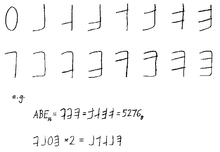User:Tripodics
The neologism "tripodics" was coined as a more-appropriate word for software programming and the study of computers. It derives from the oldest known term for automata, as used by Homer, and later cited in Aristotle's "Politics".
- There is only one condition in which we can imagine managers not needing subordinates, and masters not needing slaves.
- This condition would be that each (inanimate) instrument could do its own work, at the word of command or by intelligent anticipation, like the statues of Daedalus or the tripods made by Hephaestus, of which Homer relates that
- "Of their own motion they entered the conclave of Gods on Olympus"
- as if a shuttle should weave of itself, and a plectrum should do its own harp playing.
This usage by Homer, to describe autonomous devices that follow commands, predates by millenia Karel Čapek's coining of the term "robot" (in his play, "R.U.R"), as well as the roughly-contemporaneous introduction of the word "computer". See [ http://tripodics.com/about/aristotle.html What did Aristotle say about computers?]. 20:31, 12 September 2008 (UTC)
In Wikipedia article on "Binary prefix" <A HREF="http://en.wikipedia.org/wiki/Binary_prefix> http://en.wikipedia.org/wiki/Binary_prefix </A>
Bruce A. Martin further proposed that the units be abandoned altogether, and the letter B be used as a binary exponent, similar to E notation, to create shorthands like 3B20 for 3×220[1]

In Wikipedia article on "Hexadecimal" <A HREF="http://en.wikipedia.org/wiki/Hexadecimal#cite_note-6"> http://en.wikipedia.org/wiki/Hexadecimal</A> from section on "Representing hexadecimal"
The choice of the letters A through F to represent the digits above nine was not universal in the early history of computers. During the 1950s, some installations favored using the digits 0 through 5 with a macron character ("¯") to indicate the values 10-15. Users of Bendix G-15 computers used the letters U through Z. Bruce A. Martin of Brookhaven National Laboratory considered the choice of A-F "ridiculous" and in 1968 proposed in a letter to the editor of the ACM an entirely new set of symbols based on the bit locations, which did not gain much acceptance.[2]
In Wikipedia article on "Fortran" <A HREF="http://en.wikipedia.org/wiki/Fortran"> http://en.wikipedia.org/wiki/Fortran</A>
Letter O considered harmful[edit]
During the same Fortran Standards Committee meeting at which the name "FORTRAN 77" was chosen, a technical proposal was somehow smuggled into the official distribution, bearing the title, "Letter O considered harmful". This deceptively simple proposal purported to address the confusion that sometimes arises between the letter "O" and the numeral zero, by eliminating the letter from allowable variable names. However, the method proposed was to eliminate the letter from the character set entirely (thereby retaining 48 as the number of lexical characters, which the colon had increased to 49).
Among the "PRO" arguments was the assertion that this would also promote structured programming, by making it impossible to use the notorious
GO TOstatement as before. (TroublesomeFORMATstatements would be eliminated, as well.)The sole "CON" argument conceded that "this might invalidate some existing programs" but noted that most of these "probably were non-conforming, anyway".[3]
Missing images[edit]
IF THE ABOVE IMAGES ARE MISSING, IT IS DUE TO INTERNAL VANDALISM ON WIKIPEDIA. TO FIND THE DELETED IMAGES, GO TO:
OR find the deleted image on Wikipedia at:
This is MY user page.
The image is MINE.
Any deletion of MY image from MY user page is blatant vandalism. (If the deletion is due to a buggy 'bot then blame the writer of the 'bot.)
I have repeatedly edited the image to include my explicit release, but this stupid 'bot keeps vandalizing my page. Will somebody PLEASE fix (or kill) this vandal-bot.

See [ http://tripodics.com/about/aristotle.html What did Aristotle say about computers?].
20:31, 12 September 2008 (UTC)
http://en.wikipedia.org/wiki/Template:Attribution
| The copyright holder of this file allows anyone to use it for any purpose, provided that the copyright holder is properly attributed. Redistribution, derivative work, commercial use, and all other uses are permitted. |
{{PD}}
| The contents of this file are subject to the Mozilla Public License Version 1.1 (the "License"); you may not use this file except in compliance with the License. You may obtain a copy of the License at https://www.mozilla.org/MPL/ Software distributed under the License is distributed on an "AS IS" basis, WITHOUT WARRANTY OF ANY KIND, either express or implied. See the License for the specific language governing rights and limitations under the License. |



- ^ Letters to the editor: On binary notation, Bruce A. Martin, Associated Universities Inc., Communications of the ACM, Volume 11, Issue 10 (October 1968) Page: 658 doi:10.1145/364096.364107
- ^ Letters to the editor: On binary notation, Bruce A. Martin, Associated Universities Inc., Communications of the ACM, Volume 11, Issue 10 (October 1968) Page: 658 doi:10.1145/364096.364107
- ^ X3J3 post-meeting distribution for meeting held at Brookhaven National Laboratory in November 1976.

